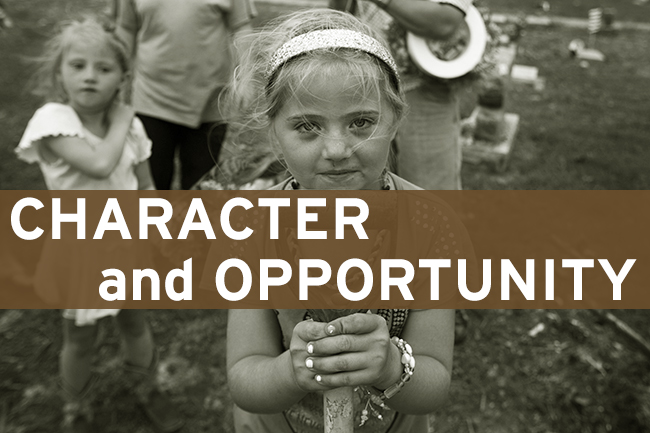In this essay from the Center on Children and Families’ Essay Series on Character and Opportunity, Stuart Butler says that we may not know exactly how to build a culture of improvement in tough neighborhoods, but unless we can, expensive public and private programs will be doomed to fail.
Why does one young woman play the lottery each week while a similarly-situated one squirrels away the same amount in her bank account? Why does one young man drop out of college after his first failing grade while his roommate persists after the same setback? Most people believe “character” influences such decisions – decisions that are strong predictors of whether someone will rise up the economic ladder or be stuck near the bottom.
The brain’s hard-wiring may have a significant influence on character development. But it is also true that the “culture” of a neighborhood play a critical role. By culture we mean the prevailing social norms, influential networks, and the behaviors expected by one’s family and friends. It’s easy to get into trouble talking about such things. When conservatives like Paul Ryan or Charles Murray use the term “virtues” to describe the personal and neighborhood attributes needed for economic mobility, critics hear that as a moral judgment about poor people. That’s why culture is the better term, because it connotes a web of influences in a neighborhood that can relentlessly shape people’s personalities and carry them along towards failure or success, whatever their underlying traits.
The culture of a neighborhood plays a large role in launching patterns of behavior that evolve into more lasting, habits – such as saving money and getting homework done, or partying and shunning work. If reinforced, habits become entrenched and the core of what we call character.
Neighborhood culture can shape an individual’s character in at least three ways. The social norms of the community can be helpful or harmful to the development of habits that evolve into character. Second, the influence of one’s immediate friends and peers seems often to be even especially potent. We see this in many critical areas, such as education. Being brought up in a tough neighborhood often means that a student who hands in homework regularly and wants to excel will face a daunting social price. Even students in more upwardly mobile neighborhoods can be held back by their friends, whose social impact seems to be even greater than the prevailing norm. Similarly, health-related behaviors that have long-term social and economic consequences, such as smoking, drug use or obesity, appear to be heavily influenced by the norms of a person’s friends and social networks. Still, we have to be cautious about blaming friends for an individual’s character formation – after all, to a significant degree one chooses one’s own friends.
Beyond just friends, associations and social institutions are a third cultural influence. Gangs are an example, often enforcing behavior patterns as the price of protection. On the other hand, the peer pressure of tightly knit school sports teams or religious institutions can be a strong and positive cultural factor in building character.
The relationship between neighborhood culture and an individual’s character is powerful, though of course not deterministic. But for younger people, whose patterns of behavior are still malleable, daily life in a poor neighborhood is characterized by a constant struggle for dominance between different these cultural pressures. Yale University’s Elijah Anderson describes this as the “Code of the Streets”, with locals referring to “street” or “decent” behavior standards that profoundly affect such work habits, school and family. And Harvard’s Robert Putnam explains that if the dominant social culture undervalues work, family stability and education it can serve to condemn young people with innate potential to a low-achieving social class.
So, is it possible to create a neighborhood culture with norms and social networks that will help build positive behavior patterns and good life choices? One approach is simply to take people out of neighborhoods that pull them down and permit or encourage them to move to communities with a more positive culture. That implies strategies such as providing housing vouchers or school choice to enable families to live or be educated in communities with positive social norms and networks. Such an approach may work well for families who already have a commitment to work and study and want their children to live in a community that reinforces those behaviors, and that’s good. But for other families the evidence of several studies suggests it is hard to overcome the effects of being brought up in a discouraging community culture simply by enabling families to move to better neighborhoods.
A more lasting and broader approach is to tackle the culture within low-income communities. That is no easy task, of course, and one where the ability of government to alter social norms may be quite limited. Still, there are some ways government at different levels may be able to assist from the sidelines.
One is to reduce regulatory obstacles to innovative neighborhood-based efforts to tackle social problems. For instance, some groups using ex-offenders as mentors appear to have achieved remarkable success at reducing widespread violence in neighborhoods. But often they face license barriers or inadequate assistance from local government.
Another is to try to actively seed stronger institutions within communities. But that has proved hard for government to do. Federal initiatives such as Promise Neighborhoods and Promise Zones may yet emulate the success of the Harlem Children’s Zone. But it always seems to be a challenge for government efforts to fund and lead efforts that partner creative local efforts rather than impose a less successful cookie-cutter approach.
The most effective strategies for building positive social institutions come from organizations with roots in the community. For instance the Harlem Children’s Zone has attracted wide attention for bringing together schools, social services and housing with remarkable results, although the nature and degree of its impact is not fully understood and sometimes questioned. Meanwhile school-based initiatives that see the school as the anchor for a range of health and social services also seem promising, as do other local efforts to build social capital. Some promising initiatives even create new networks to build a reinforcing culture among households in different neighborhoods. And religious institutions have a long track record of helping to improve the culture of neighborhoods, by praising some behaviors and stigmatizing others.
We may not know exactly how to build a culture of improvement in tough neighborhoods. But one thing is certain. Unless we can, expensive public and private programs will be doomed to fail.




